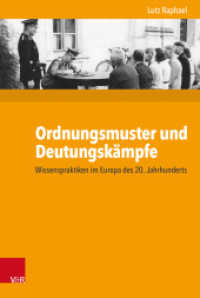- ホーム
- > 洋書
- > 英文書
- > Science / Mathematics
Full Description
Smol'yakov and Tkachenko's book is a very thorough and detailed survey of the response of hot wires and related trans ducers to a fluctuating flow field. Now that the electronic equipment needed for hot-wire anemometry is so easy to make or cheap to buy, transducer response is the most critical part of the subject - except for the fragility of the sensing element , for which textbooks are no remedy! We hope that this book will be useful to all students and research workers concerned with the theory or practice of these devices or the interpretation of results. Peter Bradshaw Imperial College London v Preface "The importance of experimental data and of experimentally established general properties is often underestimated in the study of turbulence . . . •. The most direct path is to use experimentally established properties as the foundation upon which models explaining these properties can be constructed. " M. D. Millionshchikov Turbulence belongs to a class of physical phenomena that are very frequently encountered in both nature and technology. It is the most common and also the most complicated form of motion of real liquids and gases. It is observed in the oceans, in the atmosphere, and in a very wide range of systems in engineering. The rational design of airplanes, rockets, ships, dams, hydroelectric plant, canals, turbines, ventilators, and many other technological systems must involve the consideration of turbulence.
Contents
One Statistical Description of Turbulence.- 1.1 Turbulence as a Random Process.- 1.2 Statistical Averages of Random Variables.- 1.3 Stationarity and Homogeneity.- 1.4 Spectral Decomposition.- 1.5 Connection Between Correlation and Spectral Functions.- 1.6 The Equations of Turbulences.- Two Measurement of Turbulent Fluctuations.- 2.1 Modeling of Statistical Characteristics of Turbulent Fluctuations.- 2.2 Experimental Systems.- 2.3 Thermo-anemometry (Hot-wire and Hot-film).- 2.4 Doppler method.- 2.5 Other Methods of Measuring Turbulent Fluctuations.- 2.6 Instrumental Processing of Recorded Fluctuations.- 2.7 Experimental Uncertainties.- Three Transducers of Finite Size in Turbulent Fluctuations.- 3.1 General Relationships.- 3.2 Spatial and Wave Characteristics of Simple Transducers.- 3.3 A System of Transducers as Frequency Filter.- 3.4 Correction Functions for a Field of Velocity Fluctuations.- Four Statistical Models of Turbulent Fields.- 4.1 Models of the Field as a Basis for Correcting the Results of Measurements.- 4.2 Corcos Model of the Turbulent Pressure Field and Its Simplest Modifications.- 4.3 Departure from Multiplication Hypothesis.- 4.4 Diffusion Model.- 4.5 Convection Model.- 4.6 Phase Velocity of Cross-Spectrum.- Five Correction Functions for the Pressure Fluctuation Field.- 5.1 Power Spectrum.- 5.2 The Cross-Spectrum.- 5.3 Measurements with Wave Filters.- References.








